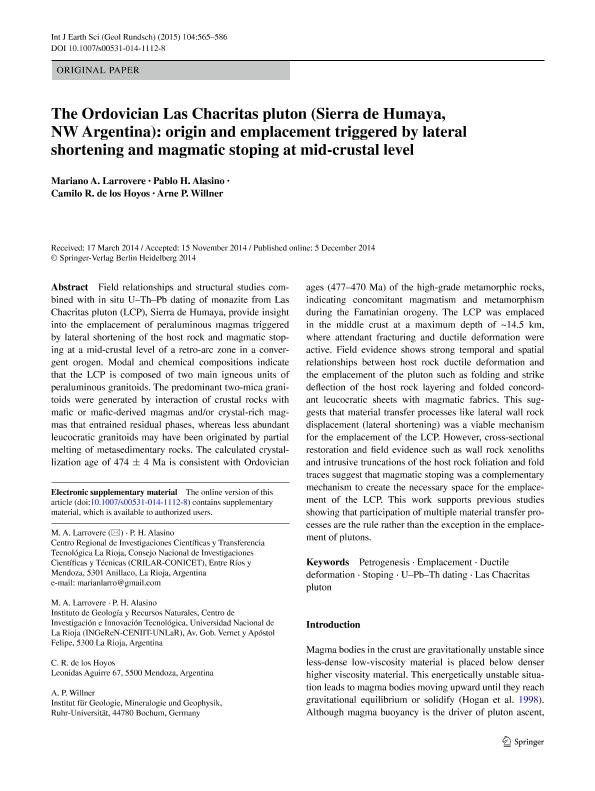Mostrar el registro sencillo del ítem
dc.contributor.author
Larrovere, Mariano Alexis

dc.contributor.author
Alasino, Pablo Horacio

dc.contributor.author
de Los Hoyos, Camilo Raul

dc.contributor.author
Willner, Arne P.
dc.date.available
2017-01-27T21:39:34Z
dc.date.issued
2015-04
dc.identifier.citation
Larrovere, Mariano Alexis; Alasino, Pablo Horacio; de Los Hoyos, Camilo Raul; Willner, Arne P.; The Ordovician Las Chacritas pluton (Sierra de Humaya, NW Argentina): origin and emplacement triggered by lateral shortening and magmatic stoping at mid-crustal level; Springer Verlag Berlín; International Journal of Earth Sciences; 104; 03; 4-2015; 565-586
dc.identifier.issn
1437-3254
dc.identifier.uri
http://hdl.handle.net/11336/12153
dc.description.abstract
Field relationships and structural studies combined with in situ U-Th-Pb dating of monazite from Las Chacritas pluton (LCP), Sierra de Humaya, provide insight into the emplacement of peraluminous magmas triggered by lateral shortening of the host rock and magmatic stoping at a mid-crustal level of a retro-arc zone in a convergent orogen. Modal and chemical compositions indicate that the LCP is composed of two main igneous units of peraluminous granitoids. The predominant two-mica granitoids were generated by interaction of crustal rocks with mafic or mafic-derived magmas and/or crystal-rich magmas that entrained residual phases, whereas less abundant leucocratic granitoids may have been originated by partial melting of metasedimentary rocks. The calculated crystallization age of 474 ± 4 Ma is consistent with Ordovician ages (477-470 Ma) of the high grade metamorphic rocks, indicating concomitant magmatism and metamorphism during the Famatinian orogeny. The LCP was emplaced in the middle crust at a maximum depth of ~ 14.5 km, where attendant fracturing and ductile deformation were active. Field evidence shows strong temporal and spatial relationships between host rock ductile deformation and the emplacement of the pluton such as folding and strike deflection of the host rock layering and folded concordant leucocratic sheets with magmatic fabrics. This suggests that material transfer processes like lateral wall rock displacement (lateral shortening) was a viable mechanisms for the emplacement of the LCP. However, cross section restoration and field evidence such as wall-rock xenoliths and intrusive truncations of the host rock foliation and fold traces suggest that magmatic stoping was a complementary mechanism to create the necessary space for the emplacement of the LCP. This work supports previous studies showing that participation of multiple material transfer processes are the rule rather than the exception in the emplacement of plutons.
dc.format
application/pdf
dc.language.iso
eng
dc.publisher
Springer Verlag Berlín

dc.rights
info:eu-repo/semantics/openAccess
dc.rights.uri
https://creativecommons.org/licenses/by-nc-sa/2.5/ar/
dc.subject
Petrogenesis
dc.subject
Emplacement
dc.subject
Ductile Deformation
dc.subject
Stoping
dc.subject
U-Pb-Th Dating
dc.subject
Las Chacritas Pluton
dc.subject.classification
Geología

dc.subject.classification
Ciencias de la Tierra y relacionadas con el Medio Ambiente

dc.subject.classification
CIENCIAS NATURALES Y EXACTAS

dc.title
The Ordovician Las Chacritas pluton (Sierra de Humaya, NW Argentina): origin and emplacement triggered by lateral shortening and magmatic stoping at mid-crustal level
dc.type
info:eu-repo/semantics/article
dc.type
info:ar-repo/semantics/artículo
dc.type
info:eu-repo/semantics/publishedVersion
dc.date.updated
2017-01-27T13:28:27Z
dc.journal.volume
104
dc.journal.number
03
dc.journal.pagination
565-586
dc.journal.pais
Alemania

dc.journal.ciudad
Berlín
dc.description.fil
Fil: Larrovere, Mariano Alexis. Consejo Nacional de Investigaciones Científicas y Técnicas. Centro Regional de Investigaciones Cientificas y Transferencia Tecnológica de Anillaco; Argentina. Universidad Nacional de la Rioja; Argentina
dc.description.fil
Fil: Alasino, Pablo Horacio. Consejo Nacional de Investigaciones Científicas y Técnicas. Centro Regional de Investigaciones Cientificas y Transferencia Tecnológica de Anillaco; Argentina. Universidad Nacional de la Rioja; Argentina
dc.description.fil
Fil: de Los Hoyos, Camilo Raul. Consejo Nacional de Investigaciones Científicas y Técnicas; Argentina
dc.description.fil
Fil: Willner, Arne P.. Ruhr-universität Bochum; Alemania
dc.journal.title
International Journal of Earth Sciences

dc.relation.alternativeid
info:eu-repo/semantics/altIdentifier/url/http://link.springer.com/article/10.1007%2Fs00531-014-1112-8
dc.relation.alternativeid
info:eu-repo/semantics/altIdentifier/doi/http://dx.doi.org/10.1007/s00531-014-1112-8
Archivos asociados
